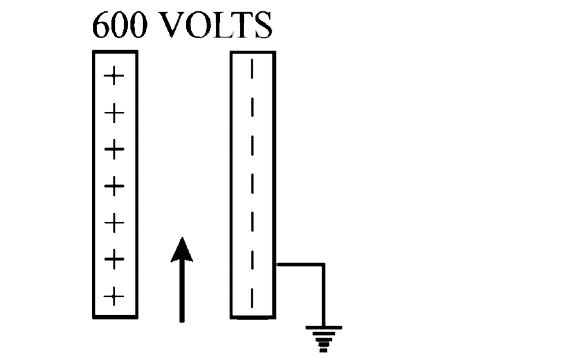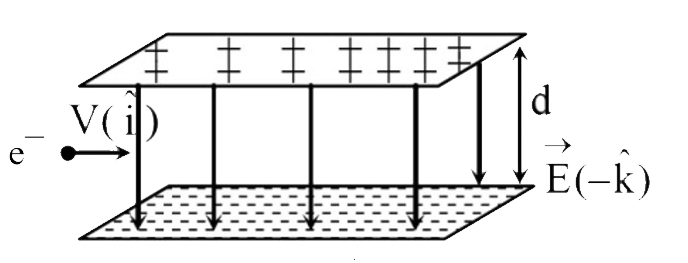A potential difference of 600V is applied across the plates of a parallel plate capacitor. The separation between the plates is 3mm. An electron is projected vertically, parallel to the plates, with a velociyt of 2×106m/s moves undeflected between the plates. The magnitude and direction of magnetic field in the region between the capacitor plates is

1T, into the plane of paper
1T, out of plane of paper
0.1T, into the plane of paper
0.1T out of plane of paper
The correct Answer is:C
Similar Questions
A potential difference of 600vo<s is applied across the plates of a parallel plate consenser . The separation between the plates is 3mm. An electron projected vertically, parallel to the plates , with a velocity of 2×106m/sec moves underflected between the plates. Find the magnitude and direction of the magnetic field in the region between the condenser plates. ( Neglect the edge effects). ( Charge of the electron = -1.6xx10^(-19) coulomb)

View SolutionA potential difference of 600vo<s is applied across the plates of a parallel plate consenser . The separation between the plates is 3mm. An electron projected vertically, parallel to the plates , with a velocity of 2×106m/sec moves underflected between the plates. Find the magnitude and direction of the magnetic field in the region between the condenser plates. ( Neglect the edge effects). ( Charge of the electron = -1.6xx10^(-19) coulomb)

View Solution
Knowledge Check
A potential difference of 500 V is applied across a paralle plate capacitor. The separation between the plates is 2×10−3m. The plates of the capacitor are vertical. An electron is projected vertically upwards between the plates with a velocity of 105m/a and it moves undeflected between the plates. The magnetic field acting perpendicular to the electric field has magnitude of
A0 Wb/m2B5/2 Wb/m2C10−6 Wb/m2D105 Wb/m2Force of attraction between the plates of a parallel plate capacitor is
Aq22ε0AKBq2ε0AKCq2ε0ADq22ε0A2KAs the distance between the plates of a parallel plate capacitor decreased
Achances of electrical break down will increases if potential difference between the plates is kept constant.Bchance of electrical break down will decreases if potential difference between the plates is kept constant.Cchance of electric break down will increases if charge on the plates is kept constantDchance of electrical break down will decrease if charge on the plate is kept constant.
A potential difference of 600 V is applied across the plates of a parallel plate condenser. The separation between the plates is 3 mm. An electron projected vertically, parallel to the plates, with a velocity of 2×106m/s moves undeflected between the plates. Find the magnitude of the magnetic field (in T) in the region between the condenser plates. (Neglect the edge effects) □ .
(Charge of the electron =1.6×10−19C)

View SolutionA potential difference of 600vo<s is applied across the plates of a parallel plate consenser . The separation between the plates is 3mm. An electron projected vertically, parallel to the plates , with a velocity of 2×106m/sec moves underflected between the plates. Find the magnitude and direction of the magnetic field in the region between the condenser plates. ( Neglect the edge effects). ( Charge of the electron = -1.6xx10^(-19) coulomb)

View SolutionForce of attraction between the plates of a parallel plate capacitor is
View SolutionAs the distance between the plates of a parallel plate capacitor decreased
View SolutionThe parallel plate capacitor has potential difference of 100 V and separation between the plate is 1 mm. An electron is projected along x axis in between the plates. If the electron comes out of the plates along the x axis undevated then the magnitude and direction of magnetic field that must be applied between the plates : (particle is projected with a velocity of 105m/s along x axis)

View Solution
